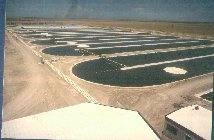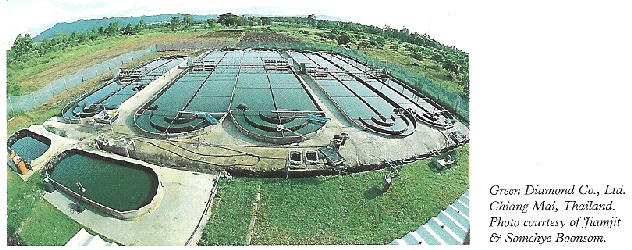|
. |
8 - systems for culturing Spirulina -
|
| 
ARTISANAL FARM |

MEDIUM SIZE FARM | 
MASS PRODUCTION FARM |
We have seen that there are three principal
categories of systems for culturing Spirulina:
small artisanal plastic basins; larger plastic
or concrete basins with more efficient stirring
mechanisms, light and temperature control
when covered by a "greenhouse",
and carbon-dioxide addition; or very large
basins with sophisticated turbulence-producing
devices, venturi micro-bubble carbon-dioxide
injection systems, and state of the art nutrient
programming and supply. The choice depends
on the number of people in emergency, the
cIimate, the availability of flat land, of
water, of the necessary chemicals, of construction
materials, of electric power, of technically
trained personnel, of finances, and any speciaI
constraints imposed by geographical or cultural
factors or traditions. You notice that I
don't even speak about closed photobioreactors
-systems wherein the culture is pumped through
plastic or glass tubing - as they are not
options for low cost production of large
quantities of Spirulina biomass. |
| It is useless at this point to present detailed
cost estimates for the three categories of
production systems. One can give only the
cost ranges of certain existing facilities.
The reason is that from one country to another
the cost of land, water, materials, labor,
etc.. varies considerably - sometimes by
a factor of 2 to 4; and that today's prices
very rarely are tomorrow's prices. |
For example, in 1998, both plastic (on wood
frames) and concrete basins
of 31 m² were
constructed in Burkina
Faso - complete with
paddlewheels and electric
drive - for approximately
$ 1650 and $ 3025 respectively.
Extrapolating,
a 100 m² plastic basin
would cost $ 5325,
while in concrete it would
cost $ 9760. A
10 m² basin consisting
of plastic film placed
over earthen side walls
and stirred by an
aquarium water pump could
cost around $ 50,
pump included.
Attention !
If the land where one wants to build a Spirulina
basin is full of termites, plastic construction
is not recommended, for the termites can
make sizeable holes in the plastic. One must
use concrete, or bricks or stones covered
wlth cement. |
If the requirement is to furnish Spirulina
for 1000 children, you can do this with several
small basins or with one of 1000 m². Here
leveling is more important, for when the
water depth is only between 20 and 10 centimeters,
a little "off level" in 50 or 100
meters can leave part of the raceway high
and dry, which would shut down the whole
system. |
Without considering cost for land, taxes,
water, or labor, the construction cost plus
the chemicals and power for the first year's
operation I estimate at about $ 22,000 -
which amounts to $ 22 per child. Of course,
this price comes down considerably when one
takes into account the fact that it wiIl
not be necessary to feed the same child the
full dose of Spirulina the entire year .This
brings the price down around $ 4 per child.
During the second and following years the
construction costs wilI be replaced by much
lower maintenance costs, so even with the
cost of personnel included, the cost per
child should drop from $22 to $6; and,
using the same time schedule for the children's
recovery, the price per child would be around
$ 1. |
For one hectare size farms, without considering
cost for land, taxes, water, or labor, I
estimate about $93,000 for construction and
first year operation - which amounts to about
$9 and thirty cents per child year or about
$1.55 per child year .
|
These figures are meant only as cost guidelines.
Every Spirulina farm is a special case -
especially after about 25 or 30 m² in size.
When the required yearly harvest quantity
is determined, a detailed study should be
made to provide a reasonably accurate cost
estimate so as to whittle down the difference
between estimated cost and actual cost -
for the two never are identical.
The politics are simple: how much does the
death of a child cost his family and his
country ?
A healthy child has a better chance of absorbing
an education and becoming a valued and productive
citizen. One sees immediately that healthy
children can make a healthy country. A healthy
country overcomes its difficulties. A sick
country disappears into the sand. Children
must not be the last, but the first item
on every nation's budget, especially during
famine emergencies. |
The purpose of the Intergovernmental Spirulina
Program - which is part of the Intergovernmental
Institute for Cooperation in Scientific Research
- with its offices in Italy and France -
is to inform governments (and individuals
too) and interest them in growing Spirulina
to improve their nutrition and health in
emergency cases.
We offer guidance in planning your Spirulina
Program and open doors to the financing of
your projects. |

A multichannel basin
A mutichannel one-hectare basin system requires
four 12-kilowatt motors for operating the
paddlewheels. This allows energy for overcoming
the resistance of mixing devices placed in
the culture flow system.
Using gravity harvesting and raising 1/4
of the culture volume 2.5 meters total height
to return the filtrate to the opposite end
of the basin requires 0.55 kilowatts for
forty minutes. Note that the opposite end
of a folded raceway can be just across a
dividing wall from the harvesting end. Price
of the pump is about $ 600.
Water depth of the culture will be
15 centimeters.
|
WEBMASTER Site'' http://Spirulina.online.fr
'' mailto:''Webmaster'' (Updated: November 2005)

|
|